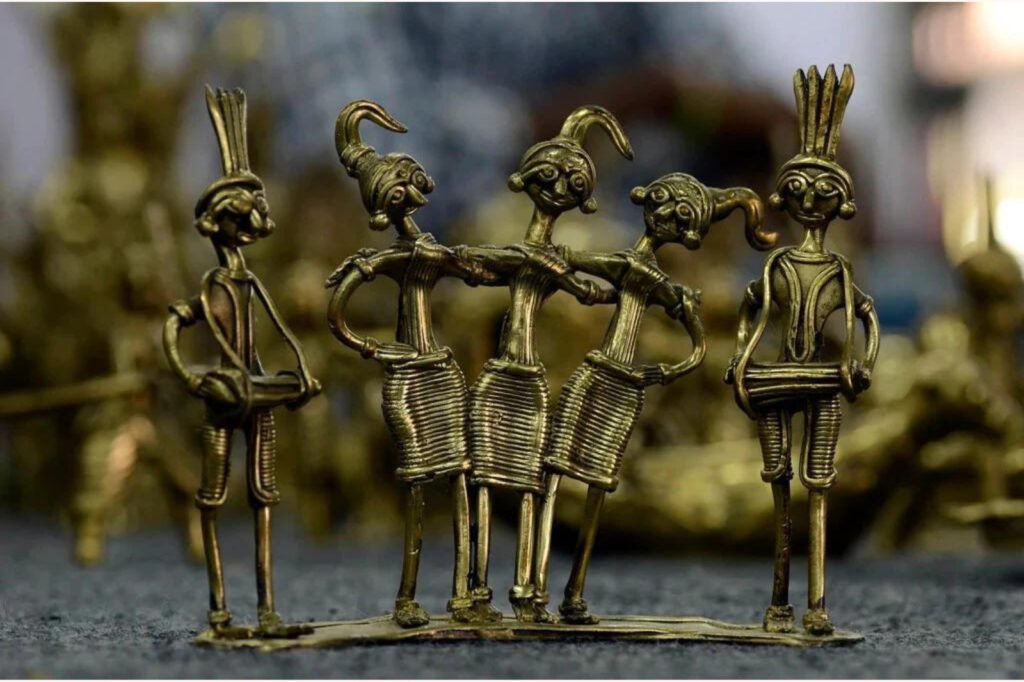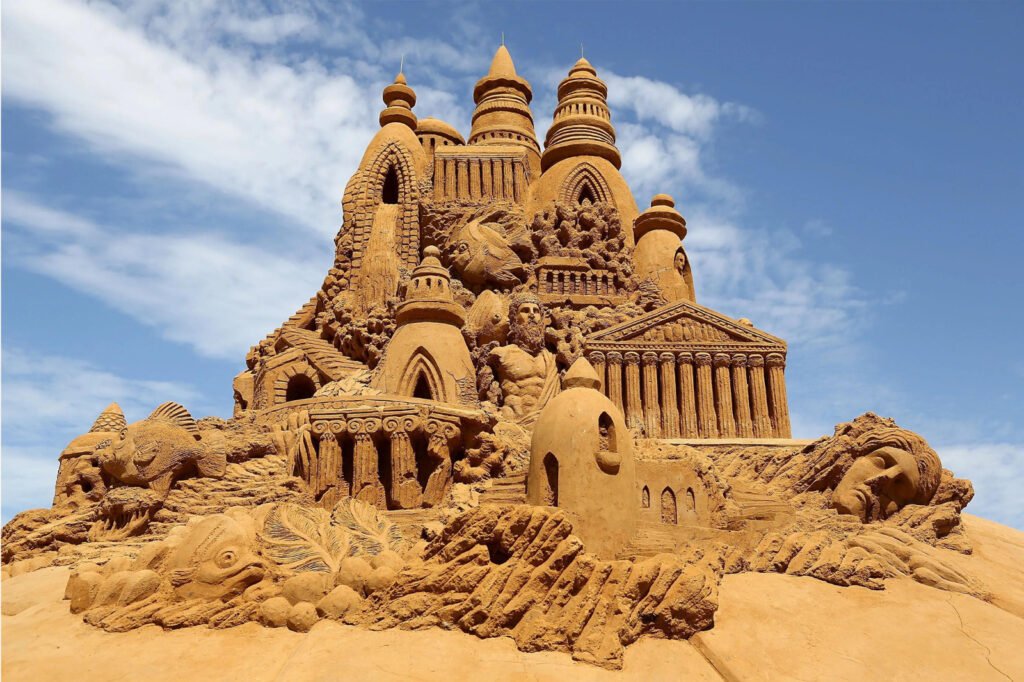Art and Craft of Odisha: 9 Art Forms That Can Relax Your Mind And Make You Calm.
"
In this article, you will learn about the beautiful art and craft culture ingrained within Odisha.
Puri Sand Art, Sambalpuri Sarees, Stone Carvings, Horn Works, Dhokra, Grass Weaving, etc., are some of the arts and crafts that are Odisha’s pride, even agreed upon by the State Government of Odisha and have been mentioned in their art and culture website.
Art has a profound impact on our minds. It makes you stop and think. It also brings peace and happiness to our minds by calming them down. Great Art can leave an effect on the reason that eases away the hectic aspect of our lives.
Peace and calm are the foundation steps to balancing our holistic well-being. This time, we decided to dig into the Art and craft of Odisha.
Odisha, with its rich tribal heritage, has great Art and craft culture. Fifty-one specifically recognized forms of Art and craft involve around 1.5 lakh people. You can call it the land of Art and crafts of the world. So here is the list of nine Art and craft that is most famous in Odisha.
Let's dive right in
Let's get started…
1. Palm Leaf Engravings
Palm leaf engravings, also known as “Tala Patra Chitra” or “Pothi, Chitra,” are a traditional painting technique. After sizing, the palm leaves, often sewn together to form a canvas for tracing the pictures with a sharp pointed iron instrument known as Lekhani. Filling grooves engraved on rows of equal-sized palm leaf panels sewed together with black or white ink.
That made me think
The Tala Patra Chitra has an aesthetic feature that can express various spiritual art and elevate the spiritual air in your home.

2. Pattachitra
It's important to take a look at this,
Pattachitra is a painting done on handmade canvas (Patti) or tasar cloth by richly colored application, inventive motifs and designs, and depiction of simple topics, typically mythical.
Superb utilitarian products like jewelry boxes, lamp sheds, and pen stands are currently being created by combining Pattachtira patterns with other materials such as wood, terracotta, plywood, etc.
Painted sarees are becoming increasingly fashionable these days. These legendary paintings, created on fabric or palm leaves, have garnered favor from art enthusiasts worldwide. An entire village in Odisha has dedicated Raghurajpur to preserve the state’s thousand-year-old art tradition.
Pattachitra is often used to tell stories. Cartoon Network had a show called Krish Tish and Baltiboy that told folktales using Pattachitra. I remember it making me so happy, and I would see the same story several times. Listening to stories can be a great relaxing activity. These days, Pattachitra art is an excellent calming art therapy.
Key Takeaway
Pattachitra Painting tradition is Centuries old and is an excellent calming art therapy.
3. Chaandua
Did you know that,
During Ratha Jatra, Chaandua is used to decorate the chariots of Lord Jagannath and his siblings and the holy trinity’s other things, such as seats and pillows, with this iconic mirror work and designs. This handwoven masterpiece of Chaandua, also known as appliqué work, is the brand ambassador of Odia handicrafts, headquartered in Pipili.
Chaandua is popular among international tourists. You can find Chandua in various forms, such as canopies, wall hangings, umbrellas, handbags, and other items.
The mandala style of art of Chaandua has a tremendous calming effect on your mind when put in with the right colors. The right patterns and right colors affect the brain by relaxing it. Our mind always seeks patterns and design repetition as a source of relaxation.
Key Takeaway
You can find Chaandua in various festive decorations. The correct pattern and colors provide a tremendous calming effect.

4. Grass Weaving
The part where it gets interesting,
The monsoon grass leaves are harvested and weaved by expert weavers to produce bowls, baskets, mats, hats, hand fans, winnowing fans, and accessories like jewelry, bags, key chains, coasters, and so on. They have found fans among foreign purchasers and visitors alike.
Trust me; there is nothing like sitting on a mat made from the golden grass weaving on your balcony next to a few plants in the morning or evening and relaxing. These grass mats aid in meditation and bring balance to your mind and body by absorbing the earth’s calming vibrations and passing them to you.
But honestly, the patterns, colors, and the various things they weave give a great look in your bedroom. They’re an aesthetic addition to your home. If the ambiance is excellent, you’ll be happy. After all, it is the ambiance that matters in our home.
Key Takeaway
Grass weaving is one of the most versatile arts where things like grass mat aid in meditation.

5. Dhokra
The interesting art of Odisha is the Dhokra goods.
Dhokra goods utilize the lost wax process, which uses pieces of various metals to give them an ancient aspect. Classic Dhokra goods, according to folklore, include animals, human heads, deity copies, lampstands, candlestands, ashtrays, and so on. It is also a tribal form of handicraft from Mayurbhanj with a rustic and old-fashioned appearance, making it a collector’s delight.
My friends who love collecting art and craft tell me Dhokra is classic. You can go right with buying Dhokra art.
4000 years old. That is how ancient the Dhokra art is. The oldest surviving artifact is the statue of a dancing girl found in Mohenjo Daro that belonged to the Indus Valley Civilisation – a statue rather famous among historians, art lovers, and archeologists alike.
According to Carl Jung, a psychologist, the motifs used in this Dhokra art have many meanings. Carl Jung believed that much such art could impact our minds and aid in wellness.
Key Takeaway
Dhokra is one of the oldest forms of art found in the excavations of the Indus Valley Civilization, and they impact the overall well-being of individuals.

6. Horn Works
Look at this,
This craft, which originated in Parlakhemundi, is distinct due to its polished gloss and finish, and it is also an alternative to the use of ivory for art and craft. Handmade combs, cranes, horns, birds, idols, and creatures such as bulls, deer, elephants, and so on are in high demand in domestic and international markets.

7. Stone Carvings
In my opinion,
One look at the ancient temples of Odisha will tell you the enchanting beauty of its stone carving and even the skills of the stone carvers. Even today, this craft has remained in popularity in Odisha. Many families still do stone carving for a living.
Many stone sculptures in Odisha run a flourishing business here in the region, where they export most of the stone sculptures of various gods and goddesses to various parts of the world.
The artisans make beautifully polished plates, containers, cups, glasses, and Kunda from stone. They even create much stuff such as candle stands, pen stands, paperweights, bookends, lamp bases, and stoneware utensils from stones. These things are used for Pujas, ritual worship, and for daily eating.
Stone is a great conductor of energy flows. Several spiritual Gurus say this. It creates an incredible impact on us. It can remove negative energy and imbibe us with positive energy. Hence, many old temples in Odisha are all built using stones.
Not to mention that stone carvings are absolutely a delight to the eye. So, if they’re pretty and can turn our Pooja room into a higher space of positive energy, why not?
Key Takeaway
Stone carvings were our country’s most visible art form and aid in energy flows.
8. Sambalpuri Sarees
If there's one thing particular to Odisha, then it is this.
The GI Tag of Odisha is its Sambalpuri Sarees. It is a handwoven bandha (ikat) sari (also known as a “sambalpuri bandha” sadhi or saree) in which they tie-die, warp, and weft before weaving. Originally, Odisha manufactures its Sambalpuri Sarees in Sambalpur (that’s where it gets its name from), Balangir, Bargarh, Boudh, and Sonepur.
The sari is a traditional female clothing in the Indian subcontinent that consists of a 4-meter-long to a 9-meter-long strip of unstitched cloth draped over the body in various ways.
Sambalpuri saris are known for incorporating traditional designs such as shankha (conch), chakra (wheel), and phula (flower), all of which have deep symbolism with the local Odia color red, black, and white.
The red and white colors represent prosperity and peace.
9. Sand Art
This is something that you simply cannot miss,
Odisha is the home of Sand Art. It then expanded all across the world. Sand Art is the creation of sculptures out of the sand. It is much simpler and faster than stone cutting.
Sand Art uses just fine-grained sand and water. An artist can create a stunning and appealing sculpture on the beach using fine-grained sand and the magic of their fingertips.
The State of Odisha even holds Sand Art Festival. The astounding displays of sand artists from India and many other countries are honored during the International Sand Artist Festival where many beautiful forms will be fashioned out of soft golden sands.
There are very few people who leave their footprints on the sand. One of them is Sudarsan Pattnaik. He has magic fingers, with unlimited potential and with immense heat to create something new on the sand. He had always dreamed that he would win a prize at an international level. For his excellent talent, he travels to many countries like London, France, Scotland, China, Holland, Singapore, Denmark, and Italy. .
Sudershan Pattnaik is also appreciated by many for his attractive sand sculpture. Now he has become an international artist. In the World Masters Sand Sculpture Championship held in Italy in July 2001, he represented India and got 3rd prize as the first Indian.
“Golden Sand Art Institute ” which is an open-air institute in Puri Beach behind Mayfair Hotel started in the year 1995. Around 50 students are taking training in this institute including tourists. Tourists can take a basic 7-10 days familiarization course. Beautiful gallery on the beach can be observed on the beach in the evening from 4-6 P.M.
This Sand art has mythological origins as well. Lord Balrama Das, the poet of Dandi Ramayan, was a devoted follower of Bhagwan Jagannath of Puri. It is believed that he attempted to offer his salutations to Shri Jagannath by climbing the chariots while the idols were out on the Ratha Yatra.
The chariot’s priests, however, forbade him from ascending and questioned his devotion to the Lord. In retaliation, the poet carved out statues of Shri Jagannath, Shri Balabhadra, and Devi Subhadra and began fervently praying to these sculptures. The legend claims that because of his dedication, the original idols disappeared from the chariot and emerged at the site of Balrama Das’ sculptures.
Trust me on this one, the moment you will see all these Sand Art, you would feel extremely satisfied in comparison to those ‘Satisfying Art Videos’ on YouTube will seem extremely dull in comparison.
Key Takeaway
Sand Art has taken Odisha to the international stage, and watching them makes you feel highly satisfying.
Final Thoughts
All in all,
Utkala, Orissa, and Kalinga. Many names have known Odisha, but one thing that remains common in Odisha is its art and craft heritage and its appreciation for it. The state even conducts over 5000 workshops teaching various people art and craft specific to Odisha. It isn’t just art for them. It is their livelihood and a way of expressing their love.
Subscribe to new post
The One Liner
Useful Links
Order Related Queries
Useful Links
Order Related Queries







